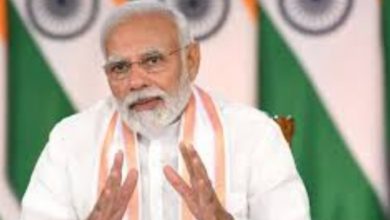New York warehouse workers vote to form first US union at Amazon

It was a union organising campaign that few expected to have a chance. A handful of employees at Amazon’s massive warehouse on Staten Island, operating without support from national labour organisations, took on one of the most powerful companies in the world.
And, somehow, they won.
Workers at the facility voted a wide margin to form a union, according to results released Friday, in a landmark win for a campaign targeting the country’s second-largest employer and one of the biggest victories for organised labour in a generation.
Employees cast 2,654 votes to be represented Amazon Labour Union and 2,131 against, giving the union a win more than 10 percentage points, according to the National Labour Relations Board. More than 8,300 workers at the building, the only Amazon fulfillment center in New York City, were eligible to vote.
The win on Staten Island comes at a perilous moment for labour unions in the United States, which saw the portion of workers in unions drop last year to 10.3%, the lowest rate in decades, despite widespread labour shortages, pockets of successful labour activity and rising public approval.
Critics say traditional unions haven’t spent enough money or shown enough imagination in organising campaigns and that they have often bet on the wrong fights. Some point to tawdry corruption scandals.
Amazon employees waiting to vote in the parking lot of the company’s JFK8 fulfillment center on Staten Island in New York City on March 25, 2022. (DeSean McClinton-Holland/The New York Times)
The union victory at Amazon, the first at the company in the US after years of worker activism there, offers an enormous opportunity to change that trajectory and build on recent wins. Many union leaders regard Amazon as an exential threat to labour standards because it touches so many industries and frequently dominates them.
But the win a little-known, independent union with few ties to exing groups appears to raise as many questions for the labour movement as it answers: not least, whether there is something fundamentally broken with the traditional bureaucratic union model that can only be solved replacing it with new worker-led organisations.
The Staten Island outcome came on the heels of what is trending toward a narrow loss the Retail, Wholesale and Department Store Union at a large Amazon warehouse in Alabama in a campaign. The vote is close enough that the results will not be known for several weeks as contested ballots are litigated.
The surprising strength shown unions in both locations most likely means that Amazon will face years of pressure from labour groups and progressive activs working with them. As a recent string of union victories at Starbucks has shown, wins at one location can provide encouragement at others.
Signs carried members of the Amazon Labour Union organizing committee outside of the National Labour Review Board’s offices in Brooklyn, on April 1, 2022. (DeSean McClinton-Holland/The New York Times)
Amazon hired voraciously over the past two years and now has 1.6 million employees globally. But it has been plagued high turnover, and the pandemic gave employees a growing sense of power while fueling worries about workplace safety. The Staten Island warehouse, known as JFK8, was the subject of a New York Times investigation last year, which found that it was emblematic of the stresses in Amazon’s employment model.
“The pandemic has fundamentally changed the labour landscape,” said John Logan, a professor of labour studies at San Francisco State University. “It’s just a question of whether unions can take advantage of the opportunity that transformation has opened up.”
Standing outside the NLRB office in Brooklyn where the ballots were tallied, Chrian Smalls, a former Amazon employee who started the union, popped a bottle of Champagne before a crowd of supporters and press. “To the first Amazon union in American hory,” he cheered.
In an unsigned statement on its corporate blog, Amazon said, “We’re disappointed with the outcome of the election in Staten Island because we believe having a direct relationship with the company is best for our employees.”
The company said it was evaluating its options, including potentially filing an objection to “inappropriate and undue influence” the NLRB for suing Amazon in federal court last month.
In that case, the NLRB asked a judge to force Amazon to swiftly rectify “flagrant unfair labour practices” that it said took place when Amazon fired a worker who became involved with the union. Amazon argued in court that the labour board abandoned “the neutrality of their office” filing the injunction just before the election.
Amazon would need to prove that any claims of undue influence “destroyed the so-called laboratory conditions for the election or had a tendency to interfere with free choice,” said Wilma Liebman, the chair of the NLRB under former President Barack Obama.
The near-term question facing the labour movement and other progressive groups is the extent to which they will help the upstart Amazon Labour Union withstand potential challenges to the result and negotiate a first contract, such as providing resources and legal talent.
“The company will appeal, drag it out — it’s going to be an ongoing fight,” said Gene Bruskin, a longtime organiser who helped notch one of labour’s last victories on this scale, at a Smithfield meat-processing plant in 2008, and has informally advised the Staten Island workers. “The labour movement has to figure out how to support them.”
Sean O’Brien, the new president of the 1.3 million-member International Brotherhood of Teamsters, said Thursday that the union was prepared to spend hundreds of millions of dollars unionising Amazon and to collaborate with a variety of other unions and progressive groups.
“We’ve got a lot of partners in labour,” O’Brien said. “We’ve got community groups. It’s going to be a large coalition.”
A culture of fear created intense productivity monitoring that was documented the Times at JFK8 has been a key motivation for the unionisation drive, which started in earnest almost a year ago. The Amazon facility offered a lifeline to laid-off workers during the pandemic but burned through staff and had such poor communication and technology that workers inadvertently were fired or lost benefits.
Chrian Smalls, president of the Amazon Labour Union, center, celebrates with other members outside of the National Labor Review Board’s offices in Brooklyn, on April 1, 2022. (DeSean McClinton-Holland/The New York Times)
For some employees, the stress of working at the warehouse during Covid-19 outbreaks was a radicalising experience to take action. Smalls, the president of the Amazon Labour Union, said he became alarmed in March 2020 after encountering a co-worker who was clearly ill. Fearing an outbreak, he pleaded with management to close the facility for two weeks. The company fired him after he helped lead a walkout over safety conditions in late March of that year.
Amazon said at the time that it had taken “extreme measures” to keep workers safe, including deep cleaning and social dancing. It said it fired Smalls for violating social dancing guidelines and attending the walkout even though he had been placed in a quarantine.
After workers at Amazon’s warehouse in Bessemer, Alabama, overwhelmingly rejected the retail workers union in its first election last spring, Smalls and Derrick Palmer, an Amazon employee who is his best friend, decided to form a new union, called Amazon Labour Union.
While the organising in Alabama included high-profile tactics, with progressive supporters like Sen. Bernie Sanders visiting the area, the organisers at JFK8 took a somewhat different approach. Their insider status helped them build support, as they wore shirts and masks bearing the union’s logo in the building and posted on internal message boards. (The retail workers said they were hamstrung Covid-19 during their initial election in Alabama and did far more in-person organising this year.)
People gather outside of the National Labour Review Board’s offices in Brooklyn, on April 1, 2022. (DeSean McClinton-Holland/The New York Times)
For months, they set up shop at the bus stop outside the warehouse, grilling meat at barbecues and at one point even passing out marijuana. They were active on social media, with TikTok videos and regular tweets about Amazon’s campaign tactics.
They also filed numerous unfair labour practice charges with the NLRB when they believed Amazon infringed on their rights. The labour agency found merit in several of the cases, some of which Amazon settled in a nationwide agreement to allow workers more access to organise on-site.
At times the Amazon Labour Union stumbled. The labour board determined this fall that the fledgling union, which spent months collecting signatures from workers requesting a vote, had not demonstrated sufficient support to warrant an election. But the organisers kept trying, and late January they had finally gathered enough signatures.
Amazon played up its minimum wage of $15 an hour in advertising and other public relations efforts. The company also waged a full-throated campaign against the union both while it tried to qualify for the election and once the vote was set, texting employees and mandating attendance at anti-union meetings. It spent $4.3 million on anti-union consultants nationwide last year, according to annual disclosures filed Thursday with the Labour Department.
In February, Smalls was arrested at the facility after managers said he was trespassing while delivering food to co-workers and called the police. Two current employees were also arrested during the incident, which appeared to galvanise interest in the union.
In the run-up to the vote, the union projected several images onto the front of the facility on Staten Island, including the message, “They Arrested Your Coworkers.”
The difference in outcomes in Bessemer and Staten Island may reflect a difference in receptiveness toward unions in the two states — roughly 6% of workers in Alabama are union members, versus 22% in New York — as well as the difference between a mail-in election and one conducted in person.
But it may also suggest the advantages of organising through an independent, worker-led union rather than a traditional one. In Alabama, union officials and professional organisers were still barred from the facility under the settlement with the labour board. But at the Staten Island site, a larger portion of the union leadership and organisers were current employees, giving them more direct access to co-workers.
“What we were trying to say all along is that having workers on the inside is the most powerful tool,” said Palmer, who makes $21.50 an hour. “People didn’t believe it, but you can’t beat workers organising other workers.”
The independence of the Amazon Labour Union also appeared to make Amazon’s anti-union talking points less effective. Over the course of hundreds of anti-union meetings with employees, the company suggested that the Amazon Labour Union was an interloper seeking to come between the company and its employees and use their money for its own purposes.
But these critiques were easier for the union to dispel there.
On March 25, workers at JFK8 started lining up outside a tent in the parking lot to vote. And over five voting days, they cast their ballots to form what may become the first union at Amazon’s operations in the US.
Another election, brought also Amazon Labour Union at a neighbouring Staten Island facility, is scheduled for late April.





